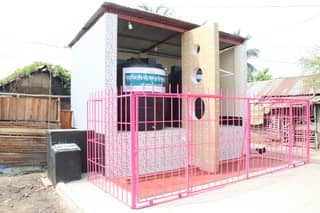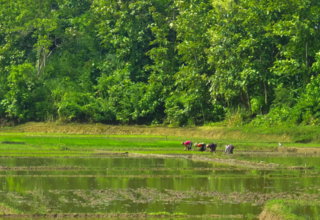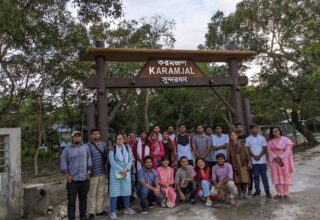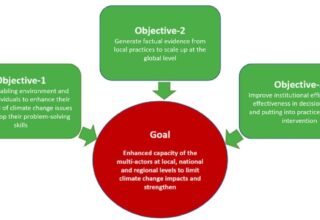
Among the urban hotspots, Rajshahi and Khulna are two cities where around 76% and 55% of climate migrants live respectively (GIZ, 2019). These destinations of the climate migrants are also vulnerable to climate change related hazards thus the people coming to the cities or those who are already living there are both at the risk of climate change impacts.
Climatic hazards in RCC and KCC: Exposures and Sensitivities
Climate migrants and other vulnerable communities in slums of Rajshahi and Khulna are exposed to a number of climatic hazards. In Khulna City Corporation (KCC), communities in slums mainly suffer from the adverse impacts of variation in temperature and rainfall, water logging/drainage congestion, cyclone and storm surges, salinity intrusion, sea level rise (SLR), coastal flood and so on. On the other hand, slum communities of Rajshahi experience flood, drought, river bank erosion, rising temperature, lack of rainfall, heat wave, cold wave and so on. According to a recent analysis, based on the meteorological data provided by Bangladesh Meteorological Department (BMD), the annual average maximum temperature in both Rajshahi and Khulna shows an increasing trend of 0.020C/yr during 1981-2020.
The annual average minimum temperature in both Rajshahi and Khulna also depicts an increasing trend (0.030C/yr) during 1981-2020. During 1981-2020, the annual rainfall (total) in Rajshahi has shown a sharp decreasing trend of (-8.13 mm/yr) and a (-0.65 mm/yr) in Khulna.
The above-mentioned climatic hazards are causing a series of sensitivities including WASH crisis, especially during the disaster periods. The health crisis is another reality during waterlogging, flooding, cyclone and storm surge, heat wave, cold waves and so on. People of different age groups suffer from different water and vector borne diseases like diarrhoea, cholera and dengue. The overall environment of these low-income urban communities also becomes unhygienic easily during disasters as there is lack of drainage system and unplanned establishments. The communities often do not have proper walkways and during monsoon water logging or drainage congestions, movement eventually gets highly disrupted. Finally, these crises affect the lives and livelihoods of the climate migrants.
What CBF is doing to enhance resilience of the climate migrants and other vulnerable
The Climate Bridge Fund (CBF) is a trust fund established by the BRAC in November 2019, with support from the Government of Germany through KfW. CBF has currently four ongoing adaptation projects at Rajshahi and Khulna City Corporations which already covered 42,853 climate migrants and vulnerable population (including 31,837 female, 11,012 male and four transgender people).These four projects are being implemented by Health, Nutrition and Population Programme (HNPP), BRAC, Ultra-Poor Graduation Programme (UPGP) jointly with Disaster Risk Management Programme (DRMP), BRAC, WaterAid Bangladesh in partnership with Village Education Resource Center (VERC), and Caritas Bangladesh.
The projects are multi-dimensional addressing a wide range of challenges in the target cities. The focus of the projects includes access to improved and sustainable water, sanitation and hygiene services (throughout the year), livelihood support to both men and women with capacity building, health services and awareness raising on climate sensitive diseases, walkways and drainage support, community led solid waste management, household-based vegetable farming, housing, and improve cook stoves which largely address the needs and climate vulnerabilities on social, ecological and physical infrastructures in the target slums.
Areas of improvement in designing adaptation measures
In our opinion, the comprehensive adaptation measure requires at least three major elements in its design. First element is the assessment of current and potential climate vulnerabilities. It is important to conduct the vulnerability assessment of the target communities with their active participation. While doing that, a top-down approach which allows future risk projections ensures the comprehensiveness of the assessment. As mentioned earlier, there has been an increase of 0.02℃/yr in the annual average temperature from 1981 to 2020. It is expected that the annual average maximum temperature will be increased by 1.6℃ by 2050 in both Rajshahi and Khulna. On the other hand, the average rainfall in Rajshahi and Khulna during 2020 were 1409mm and 1554mm respectively. It has also been found that there is a sharp decreasing trend in annual rainfall by -8.13mm/yr and -0.65 mm/yr in Rajshahi and Khulna respectively from 1981, which means that the annual rainfall in Rajshahi and Khulna may be only 1163 mm and 1544 mm respectively in the year 2050. The data also clearly indicates that the frequency of heatwaves sharply increased for both cities in the 40-year period, 1981-2020. In addition, salinity intrusion, SLR, frequency and intensity of the cyclonic events in the Southwest coast is also expected to be increased in future. If the adaptation measures are not designed considering the current and future vulnerabilities of the primary and secondary hazards of climate change, then measures will not be effective and sustainable.
Second element is the compound impacts of different climatic hazards which need to be analyzed and considered in adaptation design as well. The third element is taking advantage of new potential benefits while designing adaptation measures. As one of the CBF projects built a submersible pump which is solar powered and also a rain water harvesting system in it to decrease the pressure on ground water during the monsoon/post monsoon. The projects often just focus on one element and that lacks the comprehensiveness of the adaptation. It is important to understand the actual or expected climate stimuli to ensure if an adaptation measure is sufficient and effective. The hazards caused or stimulated by climate change are multidimensional and impact a vast range of sectors including agriculture, water, health, environment, infrastructure and so on. We should assess and explore thoroughly so that we can find out the most effective measures for that context.
CBF is trying to explore the comprehensive adaptation measures based on the field realities through the experience of the projects. What we have learned from our experience so far is that it is a continuous learning process and the project and the team should be flexible and adaptive to accommodate the learning throughout the project period to find out the best practices.
Originally this article was published on August 04, 2022 at Dhaka Tribune.
Dr Golam Rabbani is the head of the Climate Bridge Fund (CBF) Secretariat, BRAC. Can be reached at rabbani.golam@brac.net
Anindita Hridita is working with CBF as senior manager, operations and can be reached at anindita.h@brac.net






